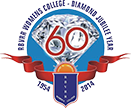- Student will be able to recognize algebraic structures that arise in matrix algebra, linear algebra and will be able to apply the skills learnt in understanding various such subjects. See the value of group theoretic methods in the generality of the approach and to otherwise intractable counting problems.
- Understand formal mathematical definitions, theorems and apply them to prove statements about real-valued functions. It enhances the understanding of Integration process and adopts critical thinking.
- Apply the fundamental concepts of Ordinary Differential Equations and Partial Differential Equations and the basic numerical methods for their resolution.
- Formulate and prove conjectures about numeric patterns and produce rigorous arguments centered on the material of number theory and attempt unsolved problems that have been daunting mathematicians for centuries providing unlimited opportunities to expand the frontiers of mathematical knowledge.
- Understand and prove Lindelof’s theorem, Ascoli’s theorem, Urysohn’s Lemma, Tietze Extension theorem, Urysohn’s Imbedding theorem and property of continuous function on a connected space.
- Learn techniques of Complex Analysis that make practical problems easy, describe domains and compute limits in the complex plane. To use the Cauchy-Riemann equations to obtain the derivative of complex functions, evaluate integrals along a path as well as using Cauchy -Residue theorem.
- Understand Graph theoretical applications in Operations Research to find solution to travelling salesman problem , Konigsberg bridge problem, Electrical network problem, Utilities problem ,Seating Problem and LPP problems
- Recognize the different Integral Transforms and apply the knowledge to find the solutions of differential equations , Partial differential equations , Initial and boundary value problems
- Students will able to use the basic principles of software engineering in managing complex software project.
- To understand the fundamental concepts of the space of admissible variations and concepts of a weak and a strong relative minimum of an integral. To outline exact, approximate, analytical and numerical methods for solving linear and non-linear equations encountered in various fields of science.
- Fundamental applications of functional analysis and the concepts associated with the dual of a linear space in pure mathematics
- Understand the construction of particular measures, present sophisticated mathematical arguments and rigorous proofs.
- Understand Spectral properties of boundary linear operators, operator equations involving compact linear operators, properties of projection operators





